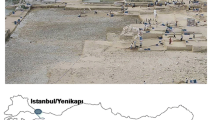Abstract
Morgagni died on December 5, 1771, 89 years old, and was buried in Saint Maxim Church in Padua, where his wife and five of his 15 children, four daughters, and one son were already buried. In 1868 and 1900, the tomb was opened to identify Morgagni. Among the remains of several adult individuals, two skulls considered of very old persons were identified and replaced in an earthenware jar inside the sepulcher. In 2011, we opened the tomb and found the remains described during the first two identifications, but additionally, we found the skulls fragments of three very young individuals which could have been Morgagni’s children. An anthropological analysis confirmed that one of the skulls inside the earthenware jar belonged to the oldest individuals (“senilis”) between those found in the tomb. A genetic analysis proved a kinship between this skull and the fragments of young individuals (one male and two females), supporting the hypothesis that they were Morgagni and his children. In conclusion, thanks to the interaction between historical studies, anthropological research, and molecular analysis that reinforce each other, we can assume that the skull is Giovanni Battista Morgagni’s and that the series of skull fragments are from his children who were buried together with their parents.






Similar content being viewed by others
References
Zampieri F, Zanatta A, Thiene G (2014) An etymological “autopsy” of Morgagni’s title: de sedibus et causis morborum per anatomen indagatis (1761). Hum Pathol 45:12–16
Zampieri G (2012) Introduzione. In: Zampieri G (Ed), La Chiesa di San Massimo in Padova Cappella Universitaria. Archeologia Storia Arte intorno alla Chiesa di San Massimo. Risultati della ricognizione scientifica della tomba di Giovan Battista Morgagni e altri interventi, L’Erma di Bretschneider, Roma, pp. 19–37
Morgagni GB (1712) Nova institutionum medicarum idea, Apud Josephum Coronam sub signo Coronae, Patavii
Thiene G (2012) Le celebrazioni morgagnane dell’anno accademico 2011-2012. In: Zampieri G (ed) La Chiesa di San Massimo in Padova Cappella Universitaria. Archeologia Storia Arte intorno alla Chiesa di San Massimo. Risultati della ricognizione scientifica della tomba di Giovan Battista Morgagni e altri interventi, L’Erma di Bretschneider, Roma, pp 219–258
Zampieri F, Zanatta A, Rippa Bonati M (2012) Ritratti di Morgagni nelle collezioni pubbliche padovane, Museo d’Arte medievale e moderna, biblioteca civica e Museo Bottacin. Cleup, Padova
Ge J, Budowle B, Chakraborty R (2011) Choosing relatives for DNA identification of missing persons. J Forensic Sci 56:S23–S28. doi:10.1111/j.1556-4029.2010.01631
Prinz M, Carracedo A, Mayr WR, Morling N, Parsons TJ, Sajantila A, Scheithauerg R, Schmitterh H, Schneideri PM (2007) DNA Commission of the International Society for Forensic Genetics (ISFG): recommendations regarding the role of forensic genetics for disaster victim identification (DVI). Forensic Sci. Int Genet 1:3–12. doi:10.1016/j.fsigen.2006.10.003
Andelinovic S, Sutlovic D, Erceg Ivkosic I, Skaro V, Ivkosic A, Paic F, Rezić B, Definis-Gojanović M, Primorac D (2005) Twelve-year experience in identification of skeletal remains from mass graves. Croat Med J 46:530–539
Alonso A, Andelinovic S, Martin P, Sutlovic D, Erceg I, Huffine E, de Simón LF, Albarrán C, Definis-Gojanović M, Fernández-Rodriguez A, García P, Drmić I, Rezić B, Kuret S, Sancho M, Primorac D (2001) DNA typing from skeletal remains: evaluation of multiplex and megaplex STR systems on DNA isolated from bone and teeth samples. Croat Med J 42:260–266
Reiss RA, Rutz B (1999) Quality control PCR: a method for detecting inhibitors of Taq DNA polymerase. Biotechniques 27(920–2):924–926
Zhou J, Bruns MA, Tiedje JM (1996) DNA recovery from soils of diverse composition. Appl Environ Microbiol 62:316–322
Sutlovic D, Definis Gojanovic M, Andelinovic S, Gugic S, Primorac D (2005) Taq polymerase reverses inhibition of quantitative real time polymerase chain reaction by humic acid. Croat Med J 46:556–562
Sutlovic D, Definis Gojanovic M, Andelinovic S (2007) Rapid extraction of human DNA containing humic acid. Croat Chem Acta 80:117–120
Loreille OM, Diegoli TM, Irwin JA, Coble MD, Parsons TJ (2007) High efficiency DNA extraction from bone by total demineralization. Forensic Sci. Int Genet 1:191–195. doi:10.1016/j.fsigen.2007.02.006
Cooper A, Poinar HN (2000) Ancient DNA: do it right or not at all. Science 289:1139
Pearson K, Bell J (1917-1919) A study of long bones of the English skeleton. Part I. The femur. In: Draper’s Company, Research Memories University of London Chapters 1-4, Biometric series 10:1–224
Black TK3rd (1978) A new method for assessing the sex of fragmentary skeletal remains: femoral shaft circumference. Am J Phys Anthropol 48:227–231
Trotter M, Gleser GC (1958) A re-evaluation of estimation of stature based on measurements of stature taken during life and of long bones after death. Am J Phys Anthropol 16:79–123
Olivier G (1963) L’estimation de la stature par les os longs des membres, Bulletins et mémoires de la société d’Anthropologie de Paris. Série XI 4:433–449
Capasso L, Kennedy KAR, Wilczak CA (1999) Atlas of occupational markers on human remains. Edigrafital s.p.a, Teramo
Meindl RS, Lovejoy CO (1985) Ectocranial suture closure: a revised method for the determination of skeletal age at death based on the lateral-anterior sutures. Am J Phys Anthropol 68:57–66
Martin R, Knuβmann VR (1988) Anthropologie. Handbuch der vergleichenden biologie des menschen. Band I. Wesen und Methoden der Anthropologie, Gustav Fischer Verlag, Stuttgart-New York
Acknowledgements
The authors express their gratitude to Antonio Mattiazzo, Archbishop of Padua, and to Giovanni Brusegan, Rector of the Saint Maxim Church, for allowing the opening of the tomb to identify the Morgagni’s remains.
Conflict of interest
We declare that we have no conflict of interest.
Author information
Authors and Affiliations
Corresponding author
Rights and permissions
About this article
Cite this article
Zanatta, A., Zampieri, F., Zampieri, G. et al. Identification of Giovanni Battista Morgagni remains following historical, anthropological, and molecular studies. Virchows Arch 465, 501–508 (2014). https://doi.org/10.1007/s00428-014-1611-9
Received:
Accepted:
Published:
Issue Date:
DOI: https://doi.org/10.1007/s00428-014-1611-9




